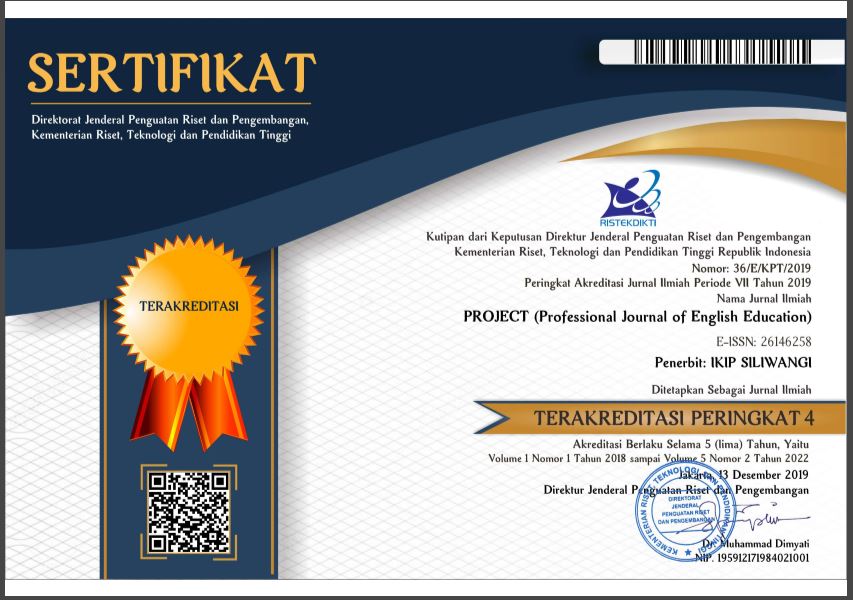INVESTIGATING GRAMMAR LEARNING STRATEGY EMPLOYED BY STUDENT ENGLISH STUDY PROGRAM
Abstrak
The study aims to investigate grammar learning strategy used by students in grammar class. It employed a survey design as part of a quantitative research methodology. The participants were students enrolled intermediate grammar class. The instruments used was questionnaire proposed by Oxford (1990), modified by Kemp (2007) and Bayou (2015). There were 32 questions divided into six strategies. The form of response was a 5-point Likert scale, with 1 representing never and 5 representing always. The result showed that meta-cognitive and compensation were two strategies frequently employed by the students.
Referensi
Al-Jarf, R. (2022). Role of instructor qualifications, assessment and pedagogical practices in EFL students’ grammar and writing proficiency. Journal of World Englishes and Educational Practices (JWEEP), 4(2), 6-17.
Assakinah, N. F., Maulana, M. I., & Latipah, E. (2022). Pentingnya Self Regulation Dalam Meningkatkan Prestasi Belajar Siswa. Jurnal Edukasi Nonformal, 3(2), 616-624.
Bayou, Y. (2015). Grammar learning strategies use of grade 11 students at Medhanealem Preparatory School: Gender in focus. Unpublished master’s thesis). Addis Ababa University, Addis Ababa.
Blau, I., Shamir-Inbal, T., & Avdiel, O. (2020). How does the pedagogical design of a technology-enhanced collaborative academic course promote digital literacies, self-regulation, and perceived learning of students?. The internet and higher education, 45, 100722.
Briewin, M., Naidu, B., & Embi, M. A. (2013). Learners of English as foreign language preference for grammar strategies in learning grammar. International Journal of English and Literature, 4(5), 249-253,
Celce-Murcia, M., Larsen-Freeman, D. (1999). The grammar book: An ESL/EFL teacher's course. Boston, MA: Heinle & Heinle.
Chatterjee, A., & Halder, S. (2023). Teaching grammar in the context of writing: A critical review. Journal of Education, 203(4), 971-983.
Cook, G. (2000). Language play, language learning. Oxford University Press.
Ghani, M. (2003). Language learning strategies employed by L2 learners. Journal of Research (Faculty of Languages & Islamic Studies), 4(1), 31-36.
Harun, N. S., Hatta, N. A. M., Mohamed, N., & Mat, A. C. (2020). Grammar Learning Strategies Preference: EILS VS EDLS.
Hattie, J., & Timperley, H. (2007). The power of feedback. Review of educational research, 77(1), 81-112.
Kemp, C. (2007). Strategic Processing in Grammar Learning: Do Multilinguals Use More Strategies?. International Journlal of Multilingualism, 241-261
Kumaravadivelu, B. (2001). Toward a postmethod pedagogy. TESOL quarterly, 35(4), 537-560.
Larsen-Freeman, D. (2001). Teaching grammar. Teaching English as a second or foreign language, 3, 251-266.
Larsen-Freeman, D. (2003a). The grammar of choice. In E. Hinkel & S. Fotos (Eds.), New perspectives on grammar teaching. Mahwah, NJ: Lawrence Erlbaum.
Larsen-Freeman, D. (2003b). Teaching language: From grammar to grammaring. Boston, MA: Thomson & Heinle.
Lee, J., & Heinz, M. (2016). English Language Learning Strategies Reported by Advanced Language Learners. Journal of International Education Research, 12(2), 67-76.
Lee, J., Schallert, D. L., & Kim, E. (2015). Effects of extensive reading and translation activities on grammar knowledge and attitudes for EFL adolescents. System, 52, 38-50.
Mandasari, B., & Wahyudin, A. Y. (2021). Flipped classroom learning model: Implementation and its impact on EFL learners’ satisfaction on grammar class. Ethical Lingua: Journal of Language Teaching and Literature, 8(1), 150-158
Muncie, J. (2002). Finding a place for grammar in EFL composition classes. ELT journal, 56(2), 180-186.
Oxford, R. L. (2003). Language learning styles and strategies: Concepts and relationships
Oxford, R. L. (1990). Language learning strategies: What every teacher should know. Newbury House
Purwanto, M. B., & Agustin, A. (2022). Reviewing on Grammar Learning Strategy Use: A Case Study of EFL Darussalam Polytechnic. JELLT (Journal of English Language and Language Teaching), 6(2), 43-57
Rahimi, M., Riazi, A., & Saif, S. (2008). An investigation into the factors affecting the use of language learning strategies by Persian EFL learners. Canadian Journal of Applied Linguistics, 11(2), 31-60.
Scarcella, R. C., & Oxford, R. L. (1992). The tapestry of language learning: The individual in the communicative classroom.
Thornbury, S. (1999). How to teach grammar. Readings in Methodology, 129.
Vijayakumar, M., Baisel, A., Subha, S., & Abirami, K. (2020). Impact of TV shows on English language acquisition. International Journal of Recent Technology and Engineering, 8(5), 2414-2416.





